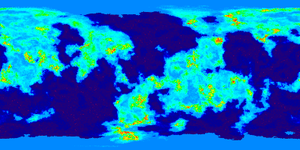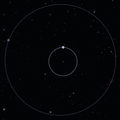Difference between revisions of "Kerbin"
GrumpyGorlox (talk | contribs) (→Orbits) |
m (Change ascent dv to 4500 m/s, which is more typical of a launch to 100 km. Don't wanna give newcomers false hope with an overly optimistic dv estimate. =)) |
||
| Line 33: | Line 33: | ||
Kerbin is the third planet in [[orbit]] around the star [[Kerbol]]. It is the third largest planet (after [[Jool]] and [[Eve]]) and the fourth largest celestial object around Kerbol (with [[Tylo]], a moon of Jool, being slightly larger). | Kerbin is the third planet in [[orbit]] around the star [[Kerbol]]. It is the third largest planet (after [[Jool]] and [[Eve]]) and the fourth largest celestial object around Kerbol (with [[Tylo]], a moon of Jool, being slightly larger). | ||
| − | Reaching a stable orbit around Kerbin is one of the first milestones a player might achieve in the game. Achieving such an orbit with a fuel-optimal ascent<ref>A fuel-optimal ascent is one which (a) minimizes velocity losses to gravity and atmospheric drag and (b) launches eastward (toward the 90 degree heading) to gain 174.5 m/s of orbital velocity for free, thanks to Kerbin's rotation.</ref> requires a delta-V of | + | Reaching a stable orbit around Kerbin is one of the first milestones a player might achieve in the game. Achieving such an orbit with a fuel-optimal ascent<ref>A fuel-optimal ascent is one which (a) minimizes velocity losses to gravity and [[atmosphere|atmospheric drag]] and (b) launches eastward (toward the 90 degree heading) to gain 174.5 m/s of orbital velocity for free, thanks to Kerbin's rotation.</ref> requires a delta-V of ≈4500 m/s,<ref>See [http://forum.kerbalspaceprogram.com/showthread.php/24017-Least-delta-v-to-orbit this challenge on the forum] and a popular [http://i.imgur.com/CEZS1.png Kerbin delta-V chart]</ref> the second largest of all celestial bodies with a solid surface after [[Eve]]. For many interplanetary missions, this represents over half of the flight's total delta-V requirement. (This is also true of Earth-based interplanetary spaceflights, leading one observer to remark that "If you can get your ship into orbit, you're halfway to anywhere."<ref>Robert Heinlein, quoted on page 194 of ''A Step Farther Out'' by Jerry Pournelle.</ref>) |
== Topography == | == Topography == | ||
Revision as of 07:57, 11 January 2013
Kerbin is the home planet of the Kerbals, the location of the Space Center, and the main focus of Kerbal Space Program. It is the Earth analog for the game. It has two moons, named Mun and Minmus.
Kerbin is the third planet in orbit around the star Kerbol. It is the third largest planet (after Jool and Eve) and the fourth largest celestial object around Kerbol (with Tylo, a moon of Jool, being slightly larger).
Reaching a stable orbit around Kerbin is one of the first milestones a player might achieve in the game. Achieving such an orbit with a fuel-optimal ascent[1] requires a delta-V of ≈4500 m/s,[2] the second largest of all celestial bodies with a solid surface after Eve. For many interplanetary missions, this represents over half of the flight's total delta-V requirement. (This is also true of Earth-based interplanetary spaceflights, leading one observer to remark that "If you can get your ship into orbit, you're halfway to anywhere."[3])
Contents
Topography
|
Kerbin has a roughly equal distribution of surface liquid water and solid land, with polar icecaps and scattered deserts. There are mountains exceeding 3 km in height, with the tallest peak being at least 3750 m in altitude.[4] Kerbin shows signs of having been impacted by an asteroid or comet. That is visible in the large crater in the western hemisphere. Prominent is the central peak, which is caused by the compression followed by the rebound of material in the center of the crater. Note: is as of v0.18 Note: There has been a change in the appearance of Kerbin in version 0.18[5], and that has contributed to the topography. All information within this article and note is valid as of version 0.17.1, Save for the thumbnail above, which is from 0.18. |
Atmosphere
Kerbin's atmosphere contains oxygen and extends to roughly 69,078 meters. Its atmosphere becomes exponentially less dense as altitude increases (with a scale height of 5 km).[6] In general, the atmospheric pressure on Kerbin, at an altitude expressed in meters, is:
The following table gives approximation of terminal velocities at different Kerbin altitudes. These are also the velocities at which a ship should travel for a fuel-optimal ascent from Kerbin, given the game's model of atmospheric drag (0.18.1).[7]
| Altitude (m) | Velocity (m/s) |
|---|---|
| 0 | 97.3 |
| 1000 | 110 |
| 3000 | 130 |
| 5000 | 160 |
| 8000 | 215 |
| 10000 | 260 |
| 15000 | 425 |
| 32000 | 2250 |
Orbits
Geosynchronous orbit is achieved at an altitude of 0.00 m (1008.9 m/s). A semi-synchronous orbit with an orbital period of 1/2 of Kerbin's rotation period (3 hours or 10800 seconds) is achieved at an altitude of 0.00 m with an orbital velocity of 0.00 m/s.
Interplanetary Travel
From the lowest stable orbit around Kerbin (70 km), the amount of delta-V needed to reach the orbits of other celestials is as follows:
| Body | Delta-V | |
|---|---|---|
| Mün | ~860 m/s | |
| Minmus | ~930 m/s | |
| Eve | ~1033 m/s | |
| Duna | ~1060 m/s | |
| Moho | ~1676 m/s | |
| Jool | ~1915 m/s | |
| Eeloo | ~2100 m/s | |
Reference Frames
| Paid (0.17) | Demo (0.13.3) | |
|---|---|---|
| Rotational/Inertial transition | 100,000 m | 70,000 m |
| Warp | Minimum Altitude | |
| 1x | Any | |
| 2x | n/a | 0 m |
| 5x | 69,078 m (above the atmosphere) | |
| 10x | 69,078 m (above the atmosphere) | |
| 50x | 69,078 m | 150,000 m |
| 100x | 120,000 m | 300,000 m |
| 1,000x | 240,000 m | 600,000 m |
| 10,000x | 480,000 m | 1,200,000 m |
| 100,000x | 600,000 m | n/a |
Gallery
- NJ6qJ.jpg
A projection map of Kerbin, as of 0.14.1 and before (including the demo).
Changes
- Terrain overhaul: Entire planet redo. Deserts, darker and greener grass, islands, darker ocean/water, snow capped mountains. Looks more realistic.
- Several Easter Eggs added.
- Airport added to island off of KSC coastline. (Not a launching point)
- Improved atmosphere visuals.
- Minmus added.
- Much more varied and taller terrain added. Prior to this, some mountain ranges exceeded 600 m in height, but the tallest point was at an altitude of approximately 900 m.
- Mün added.
- Terrain overhaul, oceans became wet.
- Atmosphere extended from ~34,500 m to ~69,000 m.
- Initial Release
Notes
- ↑ A fuel-optimal ascent is one which (a) minimizes velocity losses to gravity and atmospheric drag and (b) launches eastward (toward the 90 degree heading) to gain 174.5 m/s of orbital velocity for free, thanks to Kerbin's rotation.
- ↑ See this challenge on the forum and a popular Kerbin delta-V chart
- ↑ Robert Heinlein, quoted on page 194 of A Step Farther Out by Jerry Pournelle.
- ↑ http://kerbalspaceprogram.com/forum/index.php?topic=11388.msg176509#msg176509 [Broken Link]
- ↑ http://forum.kerbalspaceprogram.com/entry.php/247-A-Brave-New-World
- ↑ Forum thread 16000, "[KGSS] Examining Kerbin's atmosphere"
- ↑ http://forum.kerbalspaceprogram.com/showthread.php/6664-Mini-challenge-max-altitude-with-this-supplied-spacecraft?p=100912&viewfull=1#post100912






